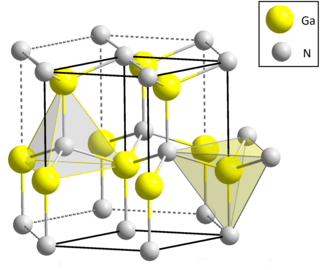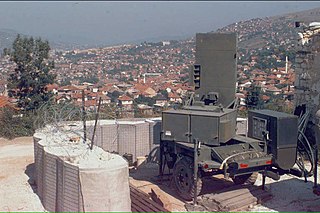History
The TPQ-53 radar's delivery on 2 July 2009 followed its successful live-fire performance testing against indirect fire from mortars, artillery and rockets from a simulated enemy. The system has been tested and approved by the US Army. TPQ-53 radar systems will replace the aging TPQ-36 and TPQ-37 medium-range radars now in the Army's inventory. In addition to its counter-fire and counter-drone missions, [2]
Prior to September 2011 This system was known as EQ-36 Counterfire Target Acquisition Radar. [3]
In June 2013 the United States Army exercised a contract option to finish out the total production of 51 systems. [4] After a contract award 24 April 2017 has completed production, the Army will hold more than 170 such systems. [5] In April 2020 the first GaN based AN/TPQ-53 was delivered to the U.S. Army [6]
After Russian-backed separatists started operating tanks in Eastern Ukraine, the U.S. started sending military items to Ukraine, including 20 AN/TPQ-53 radar systems in 2015. As a result, Ukraine's units thus equipped had casualty rates decline from 47 percent to around 18 percent. Ukrainian combat expertise with the system led to their providing training to U.S. forces. [7]

Gallium nitride is a binary III/V direct bandgap semiconductor commonly used in blue light-emitting diodes since the 1990s. The compound is a very hard material that has a Wurtzite crystal structure. Its wide band gap of 3.4 eV affords it special properties for applications in optoelectronics, high-power and high-frequency devices. For example, GaN is the substrate that makes violet (405 nm) laser diodes possible, without requiring nonlinear optical frequency doubling.

A counter-battery radar or weapon tracking radar is a radar system that detects artillery projectiles fired by one or more guns, howitzers, mortars or rocket launchers and, from their trajectories, locates the position on the ground of the weapon that fired it. Such radars are a subclass of the wider class of target acquisition radars.

The AN/MPQ-64 Sentinel is an X-band electronically steered pulse-Doppler 3D radar system used to alert and cue Short Range Air Defense (SHORAD) weapons to the locations of hostile targets approaching their front line forces. It is currently produced by Raytheon Missiles & Defense.

The AN/FPS-124 is an unattended radar (UAR) providing short range, Doppler radar surveillance of airborne targets. It provides target information to the Regional Operations Control Center (ROCC), and employs built-in-test, performance monitoring/fault isolation and system redundancy enabling it to reconfigure itself when fault detection occurs.

Hughes AN/TPQ-36 Firefinder weapon locating system is a mobile radar system developed in the mid-late 1970s by Hughes Aircraft Company and manufactured by Northrop Grumman and ThalesRaytheonSystems, achieving initial operational capability in May 1982. The system is a "weapon-locating radar", designed to detect and track incoming mortar, artillery and rocket fire to determine the point of origin for counter-battery fire. It is currently in service at battalion and higher levels in the United States Army, United States Marine Corps, Australian Army, Portuguese Army, Turkish Army, and the Armed Forces of Ukraine.

The AN/SPQ-11 Cobra Judy was a PESA radar found on the USNS Observation Island (T-AGM-23) missile range instrumentation ship.

Hughes AN/TPQ-37 Firefinder Weapon Locating System is a mobile radar system developed in the late 1970s by Hughes Aircraft Company, achieving Initial Operational Capability in 1980 and full deployment in 1984. Currently manufactured by ThalesRaytheonSystems, the system is a long-range version of "weapon-locating radar", designed to detect and track incoming artillery and rocket fire to determine the point of origin for counter-battery fire. It is currently in service at brigade and higher levels in the United States Army and by other countries. The radar is trailer-mounted and towed by a 2+1⁄3-short-ton (2,100 kg) truck. A typical AN/TPQ-37 system consists of the Antenna-Transceiver Group, Command Shelter and 60 kW Generator.

The SLC-2 Radar is a Chinese active electronically scanned array counter-battery radar designed to locate hostile artillery, rocket and ground-to-ground missile launchers immediately after firing, and to support friendly artillery by guiding counter-battery fire.
The Type 704 is a counter-battery radar designed to accurately locate the hostile artillery, rocket and ground-to-ground missile launcher immediately after the firing of enemy, and support friendly artillery by providing guidance of counter fire. Built by NORINCO, it was first displayed publicly in 1988's ASIADEX defence show.

ARTHUR is a counter-battery radar system originally developed jointly for and in close co-operation with the Norwegian and Swedish armed forces by Ericsson Microwave Systems in both Sweden and Norway. It is also used by the British Army, under the designation TAIPAN.

The AN/FPS-16 is a highly accurate ground-based monopulse single object tracking radar (SOTR), used extensively by the NASA crewed space program, the U.S. Air Force and the U.S. Army. The accuracy of Radar Set AN/FPS-16 is such that the position data obtained from point-source targets has azimuth and elevation angular errors of less than 0.1 milliradian and range errors of less than 5 yards (5 m) with a signal-to-noise ratio of 20 decibels or greater.

The Swathi weapon locating radar is a mobile artillery-locating, phased array radar developed by India. This counter-battery radar is designed to detect and track incoming artillery and rocket fire to determine the point of origin for counter-battery fire.

The AN/TPS-80 Ground/Air Task Oriented Radar (G/ATOR) is the United States Marine Corps next-generation Air Surveillance/Air Defense and Air Traffic Control (ATC) Radar. The mobile active electronically scanned array radar system is being developed by Northrop Grumman and was expected to reach initial operating capability in August 2016.

The Radar Set AN/MPQ-4 was a US Army counter-battery radar primarily used to find the location of enemy mortars and larger artillery in a secondary role. Built by General Electric, it first entered service in 1958, replacing the earlier and much simpler AN/MPQ-10. The MPQ-4 could determine the location of an enemy mortar in as little as 20 seconds by observing a single round, whereas the MPQ-10 required several rounds to be launched and could take 4 to 5 minutes to take a "fix". The MPQ-4 remained one of the primary US counter-battery systems through the late 1970s until it was replaced by passive electronically scanned array radars like the AN/TPQ-36.

The Raytheon Coyote is a small, expendable, unmanned aircraft system built by the Raytheon Company, with the capability of operating in autonomous swarms. It is launched from a sonobuoy canister with the wings deploying in early flight phase.

Aistyonok is a portable counter-battery radar system developed and produced by the state-owned Almaz-Antey corporation for the Russian Armed Forces.

Zoopark-1 1L219 is a counter-battery radar system developed by Almaz-Antey for the Soviet Armed Forces. It is a mobile active electronically scanned array radar for the purpose of enemy field-artillery acquisition. The system can detect mortar shells at a distance of up to 20 kilometers, up to 30 kilometers for artillery shells and up to 50 kilometers for ground-to-air rockets, determining location of origin of a fire. Moving ground targets can be detected at a distance of up to 40 kilometers. It reached initial operating status in 1989.

COBRA COunter Battery RAdar is a Counter-battery radar system developed jointly by Thales, Airbus Defence and Space and Lockheed Martin for the French, British and German Armed Forces. It is a mobile Active electronically scanned array 3D radar based on a wheeled chassis for the purpose of enemy field artillery acquisition.

The Centurion C-RAM, also called the Land Phalanx Weapon System (LPWS), is an American Counter-Rocket, Artillery, and Mortar (C-RAM) air defense artillery system. The system was developed in 2004, during and after the Iraq War identified a weakness in ground-based anti-projectile artillery. The system is produced by Northrop Grumman, Raytheon, and Oshkosh Corporation.


















